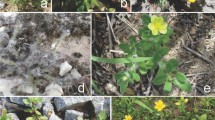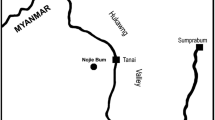Abstract
Staminate inflorescences from the Paleocene deposits of the Amur Region (Russia) are described as a new genus, Bogutchanthus N. Maslova, Kodrul et Tekleva, on the basis of micromorphological characters. The inflorescences under description combine characters of the families Platanaceae and Hamamelidaceae (order Hamamelidales). Along with capitate inflorescences, tetramerous flowers with a differentiated perianth, and the presence of staminodes—typical characters of Cretaceous platanaceous plants—the new genus also shows some features that are known in extant and fossil members of the Hamamelidaceae: a loosely packed inflorescence, free stamens, secondarily bisporangiate stamens, crescent pollen sacs, and pantocolpate pollen grains. The inflorescences are associated with entire-margined leaves of the platanoid type.
Similar content being viewed by others
References
M. A. Akhmetiev, T. V. Kezina, T. M. Kodrul, and S. R. Manchester, “Stratigraphy and Flora of the Cretaceous-Paleogene Boundary Beds in the Southeastern Part of the Zeya-Bureya Sedimentary Basin,” in Collection of Papers in Memory of Corresponding Member of the Russian Academy of Sciences Prof. V.A. Vakhrameev on Occasion of His 90th Birthday (GEOS, Moscow, 2002), pp. 275–315 [in Russian].
“Angiosperm Phylogeny Group 2003. An Update of the Angiosperm Phylogeny Group Classification for the Orders and Families of the Flowering Plants: APG II,” Bot. J. Linn. Soc. 141, 399–436 (2003).
K. Binka, J. Nitychoruk, and J. Dzierzek, “Parrotia persica C.M.A. (Persian Witch Hazel, Persian Ironwood) in the Mazovian (Holsteinian) Interglacial of Poland,” Grana 42, 227–233 (2003).
A. L. Bogle, “Floral Morphology and Vascular Anatomy of the Hamamelidaceae: The Apetalous Genera of Hamamelidoideae,” J. Arnold Arbor. 51, 310–366 (1970).
A. L. Bogle, “Floral Morphology and Vascular Anatomy of Maingaya Oliv. (Hamamelidaceae, Hamamelidoideae, Hamamelideae),” Am. J. Bot. 71(5, Part 2), 19 (1984).
A. L. Bogle, “The Floral Morphology and Vascular Anatomy of the Hamamelidaceae: Subfamily Liquidambaroideae,” Ann. Miss. Bot. Garden 73(2), 325–347 (1986).
A. L. Bogle, “Inflorescence and Flower Ontogeny in the Pseudanthium of Rhodoleia (Hamamelidaceae),” Am. J. Bot. 74, 607–608 (1987).
A. L. Bogle and C. T. Philbrick, “A Generic Atlas of Hamamelidaceous Pollen,” Contrib. Gray Herb, No. 210, 29–103 (1980).
L. E. Boothroyd, “The Morphology and Anatomy of the Inflorescence and Flower of the Platanaceae,” Am. J. Bot. 17(7), 678–693 (1930).
Č. Bůžek, F. Holý, and Z. Kvaček, “Eine bemerkenswerte Art der Familie Platanaceae Lindl. (1836) in nordböhmischen Tertiär,” Monatsb. Dtsch. Akad. Wiss. Berlin 9, 203–215 (1967).
R. J. Carpenter, R. S. Hill, and G. J. Jordan, “Leaf Cuticular Morphology Links Platanaceae and Proteaceae,” Int. J. Plant Sci. 166(5), 843–855 (2005).
P. R. Crane, S. R. Manchester, and D. L. Dilcher, “Morphology and Phylogenetic Significance of the Angiosperm Platanites hybridicus from the Palaeocene of Scotland,” Palaeontology 31, 503–517 (1988).
P. R. Crane, K. R. Pedersen, E. M. Friis, and A. N. Drinnan, “Early Cretaceous (Early to Middle Albian) Platanoid Inflorescences Associated with Sapindopsis Leaves from the Potomac Group of Eastern North America,” Syst. Bot. 18(2), 328–324 (1993).
W. L. Crepet and K. Nixon, “The Fossil History of Stamens,” in The Anther. Form, Function, and Phylogeny, Ed. by G. D’Arcy and R. C. Keating (Cambridge Univ. Press, Cambridge, 1996), pp. 25–57.
W. L. Crepet, K. C. Nixon, E. M. Friis, and J. V. Freudenstein, “Oldest Fossil Flowers of Hamamelidaceous Affinity, from the Late Cretaceous of New Jersey,” Proc. Nat. Acad. Sci. USA 89, 8986–8989 (1992).
A. Cronquist, An Integrated System of Classification of Flowering Plants (Columbia Univ. Press, New York, 1981).
T. Denk and M. V. Tekleva, “Comparative Pollen Morphology and Ultrastructure of Platanus: Implications for Phylogeny and Evaluation of the Fossil Record,” Grana 45, 195–221 (2006).
P. K. Endress, “Evolutionary Trends in the Hamamelidales-Fagales Group,” Plant Syst. Evol., Suppl. 1, 321–347 (1977).
P. K. Endress and E. M. Friis, “Archamamelis, Hamamelidalean Flowers from the Upper Cretaceous of Sweden,” Plant Syst. Evol. 175, 101–114 (1991).
E. M. Friis, P. R. Crane, and K. R. Pedersen, “Reproductive Structures of Cretaceous Platanaceae,” Kongl. Danske Vidensk. Selsk. Biol. Skr. 31, 1–55 (1988).
G. Geyer, Ultrahistochemie. Histochemische Arbeitsvorschriften für die Elektronenmikroskopie (Fischer, Jena, 1973; Mir, Moscow, 1974).
L. D. Hufford and P. K. Endress, “The Diversity of Anther Structures and Dehiscence Patterns among Hamamelididae,” Bot. J. Linn. Soc. 99(4), 301–346 (1989).
S. M. Ickert-Bond, K. B. Pigg, and Wen Jun, “Comparative Infructescence Morphology in Liquidambar (Altingiaceae) and Its Evolutionary Significance,” Am. J. Bot. 92(8), 1234–1255 (2005).
K. R. Johnson, “Description of Seven Common Fossil Leaf Species from the Hell Creek Formation (Upper Cretaceous: Upper Maastrichtian), North Dakota, South Dakota, and Montana,” Proc. Denver Mus. Nat. Hist., Ser. 3, No. 12, 1–47 (1996).
U. Kaul and R. N. Kapil, “Exbucklandia populnea—from Flower to Fruit,” Phytomorphology 24, 217–228 (1974).
T. M. Kodrul, “The Middle Tsagayan Flora of Amur River Region,” in Proc. 3rd Symp. Cretaceous Biot. K/T Boundary, Heilongjiang River Area, China, Chang-Chun (2004), pp. 17–21.
V. A. Krassilov, “Upper Cretaceous Staminate Heads with Pollen Grains,” Palaeontology 16, 41–44 (1973).
V. A. Krassilov, Tsagayan Flora of the Amur Region (Nauka, Moscow, 1976) [in Russian].
V. A. Krassilov, Cretaceous Flora of Sakhalin (Nauka, Moscow, 1979) [in Russian].
V. A. Krassilov and P. V. Shilin, “New Platanoid Staminate Heads from the Mid-Cretaceous of Kazakhstan,” Rev. Palaeobot. Palynol. 85(3/4), 207–211 (1995).
S. Magallón-Puebla, P. S. Herendeen, and P. K. Endress, “Allonia decandra: Floral Remains of the Tribe Hamamelideae (Hamamelidaceae) from Campanian Strata of Southeastern USA,” Plant Syst. Evol. 202, 177–198 (1996).
S. Magallón-Puebla, P. S. Herendeen, and P. R. Crane, “Quadriplatanus georgianus gen. et sp. nov.: Staminate and Pistillate Platanaceous Flowers from the Late Cretaceous (Coniacian-Santonian) of Georgia, U.S.A,” Int. J. Plant Sci. 158(3), 373–394 (1997).
S. Magallón-Puebla, P. S. Herendeen, and P. R. Crane, “Androdecidua endressii gen. et sp. nov., from the Late Cretaceous of Georgia (United States): Further Floral Diversity in Hamamelidoideae (Hamamelidaceae),” Int. J. Plant Sci. 162(4), 963–983 (2001).
S. R. Manchester, “Vegetation and Reproductive Morphology of an Extinct Plane Tree (Platanaceae) from the Eocene of Western North America,” Bot. Gaz. 147, 200–226 (1986).
S. R. Manchester, “Fruits and Seeds of the Middle Eocene Nut Beds Flora, Clarno Formation, Oregon,” Palaeontogr. Am., No. 58, 1–205 (1994).
V. S. Markevich, E. V. Bugdaeva, and A. R. Ashraf, “Results of Study of Arkhara-Boguchan Coal Field,” in Proc. 3rd Symp. Cretaceous Biot. K/T Boundary, Heilongjiang River Area, China, Chang-Chun (2004), pp. 41–44.
N. P. Maslova, “A New Plant of the Family Platanaceae from the Early Paleogene Reconstructed on the Basis of Leaves and Inflorescences,” Paleontol. Zh., No. 2, 89–101 (2002) [Paleontol. J. 36 (2), 207–218 (2002)].
N. P. Maslova, “Evolutionary Trends in the Family Platanaceae,” in Abstracts of Int. Symp. on Evolution of Higher Plants, MGU (Mosk. Gos. Univ., Moscow, 2003a), pp. 64–65 [in Russian].
N. P. Maslova, “Extinct and Extant Platanaceae and Hamamelidaceae: Morphology, Systematics, and Phylogeny,” Paleontol. J. 37(Suppl. 5), S467–S590 (2003b).
N. P. Maslova and L. B. Golovneva, “Lindacarpa gen. nov., a New Hamamelid Fructification from the Upper Cretaceous of Eastern Siberia,” Paleontol. Zh., No. 4, 100–106 (2000a) [Paleontol. J. 34 (4), 462–468 (2000a)].
N. P. Maslova and L. B. Golovneva, “A Hamamelid Inflorescence with in situ Pollen Grains from the Cenomanian of Eastern Siberia,” Paleontol. J. 34(Suppl. 1), S40–S49 (2000b).
N. P. Maslova and A. B. Herman, “New Finds of Fossil Hamamelids and Data on the Phylogenetic Relationships between the Platanaceae and Hamamelidaceae,” Paleontol. Zh., No. 5, 94–105 (2004) [Paleontol. J. 38 (5), 563–575 (2004)].
N. P. Maslova and A. B. Herman, “Infructescences of Friisicarpus nom. nov. (Platanaceae) and Associated Foliage of the Platanoid Type from the Cenomanian of Western Siberia,” Paleontol. Zh., No. 1, 103–106 (2006) [Paleontol. J. 40 (1), 109–112 (2006)].
N. P. Maslova and T. M. Kodrul, “New Platanaceous Inflorescence Archaranthus gen. nov. from the Maastrichtian-Paleocene of the Amur Region,” Paleontol. Zh., No. 1, 92–100 (2003) [Paleontol. J. 37 (1), 89–98 (2003)].
N. P. Maslova and V. A. Krassilov, “New Hamamelid Infructescences from the Palaeocene of Western Kamchatka, Russia,” Rev. Palaeobot. Palynol. 97, 67–78 (1997).
N. P. Maslova and V. A. Krassilov, “A New Genus of Platanaceae from the Paleocene of the Amur Region,” Paleontol. Zh., No. 1, 106–110 (2002) [Paleontol. J. 36 (1), 102–106 (2002)].
N. P. Maslova, L. B. Golovneva, and M. V. Tekleva, “Infructescences of Kasicarpa gen. nov. (Hamamelidales) from the Late Cretaceous (Turonian) of the Chulym-Enisey Depression, Western Siberia, Russia,” Acta Palaeobot. 45(2), 121–137 (2005a).
N. P. Maslova, M. G. Moiseeva, A. B. Herman, and J. Kvaček, “Did Plane Trees Exist in the Cretaceous?,” Paleontol. Zh., No. 4, 98–110 (2005b) [Paleontol. J. 39 (4), 440–453 (2005b)].
R. A. Mindell, R. A. Stockey, and G. Beard, “Anatomically Preserved Staminate Inflorescences of Gynoplatananthus oysterbayensis gen. et sp. nov. (Platanaceae) and Associated Pistillate Fructifications from the Eocene of Vancouver Island, British Columbia,” Int. J. Plant Sci. 167(3), 591–600 (2006).
T. Mione and A. L. Bogle, “Comparative Ontogeny of the Inflorescence and Flower of the Hamamelis virginiana and Loropetalum chinense (Hamamelidaceae),” Am. J. Bot. 77(1), 77–91 (1990).
K. R. Pedersen, E. M. Friis, P. R. Crane, and A. N. Drinnan, “Reproductive Structures of an Extinct Platanoid from the Early Cretaceous (Latest Albian) of Eastern North America,” Rev. Palaeobot. Palynol. 80(3/4), 291–303 (1994).
K. B. Pigg and R. A. Stockey, “Platanaceous Plants from the Paleocene of Alberta, Canada,” Rev. Palaeobot. Palynol. 70(1/2), 125–146 (1991).
D. N. Schoemaker, “On the Development of Hamamelis virginiana,” Bot. Gaz. 39, 248–266 (1905).
A. L. Takhtajan, System and Phylogeny of Flowering Plants (Nauka, Moscow, 1966) [in Russian].
A. L. Takhtajan, System of Magnoliophyta (Nauka, Leningrad, 1987) [in Russian].
M. V. Tekleva and N. P. Maslova, “New Data on the Comparative Morphology and Ultrastructure of Pollen Grains of Fossil Platanaceae,” Byull. Mosk. O-va Ispyt. Prir., Otd. Geol. 109(1), 63–69 (2004).
O. P. Tel’nova and N. R. Meier-Melikyan, Spores in Reproductive Organs of Devonian Plants (Nauka, St. Petersburg, 2002) [in Russian].
M. S. Zavada and D. L. Dilcher, “Comparative Pollen Morphology and Its Relationship to Phylogeny of Pollen in the Hamamelidae,” Ann. Miss. Bot. Garden 73, 348–381 (1986).
Z. K. Zhou, W. L. Crepet, and K. C. Nixon, “The Earliest Fossil Evidence of the Hamamelidaceae: Late Cretaceous (Turonian) Inflorescences and Fruits of Altingioideae,” Am. J. Bot. 88(5), 753–766 (2001).
Author information
Authors and Affiliations
Corresponding author
Additional information
Original Russian Text © N.P. Maslova, T.M. Kodrul, M.V. Tekleva, 2007, published in Paleontologicheskii Zhurnal, 2007, No. 5, pp. 89–103.
Rights and permissions
About this article
Cite this article
Maslova, N.P., Kodrul, T.M. & Tekleva, M.V. A new taxon of staminate inflorescences Bogutchanthus gen. nov. (Hamamelidales) from the Paleocene of the Amur Region. Paleontol. J. 41, 564–579 (2007). https://doi.org/10.1134/S0031030107050127
Received:
Issue Date:
DOI: https://doi.org/10.1134/S0031030107050127




